A 92-page report on the Tara Health Foundation website should be reviewed by pro-life advocates across the nation, as it details upcoming strategy from abortion supporters, which includes the push for “home use” abortions. Live Action News has previously covered how the philanthropic Foundation is behind funding RU-486 pills on college campuses in California and behind propping up the abortion chain Whole Woman’s Health while it battled safety regulations in Texas.
The “US Reproductive Health Investment Case” report from October of 2017 was put together by the “Reproductive Health Investors Alliance… to determine the most effective opportunities to improve access to reproductive health services… using both philanthropy and impact investments.” The report’s stated goal? “To increase the supply of and demand for… contraceptive and abortion services.”
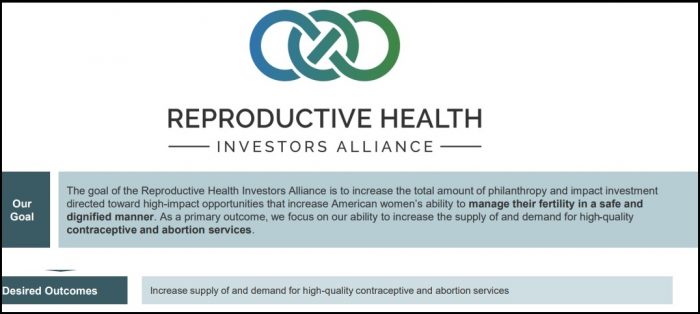
TARA Reproductive Health Investors Alliance Goal
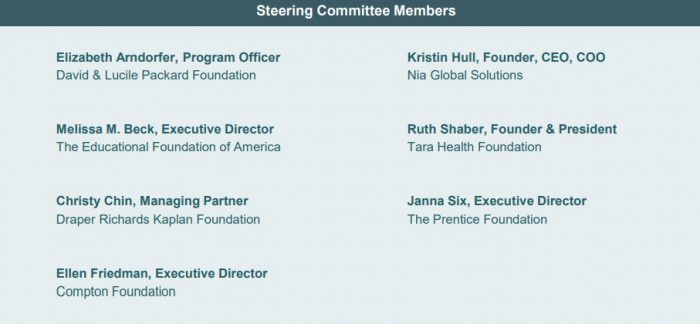
Reproductive Health Investors Alliance Steering Committee
The report includes statistics and analysis from “ANSIRH, the Guttmacher Institute, Ibis Reproductive Health, and the Kaiser Family Foundation.”
It should be noted that these agencies have abortion connections:
- Guttmacher is a former “special affiliate” and research arm of Planned Parenthood.
- TARA’s founder, Ruth Shaber, previously held research positions at Kaiser Permanente.
- Live Action News previously reported that ANSIRH’s founder, the late abortionist Felicia H. Stewart, was a physician on staff with more than one Planned Parenthood, and is credited with the introduction of the “Plan B” pill. She also led the push for midwives and nurse practitioners to commit abortions in California and served on the boards of NARAL Pro-Choice America and the National Abortion Federation.
“Experts” who contributed to the report include:
- Lana Dakan, PO, Population & RH, Packard Foundation
- Christine Dehlendorf, Associate Professor, UCSF Bixby Center for Global Reproductive Health
- Ginny Ehrlich, CEO, National Campaign to Prevent Teen and Unplanned Pregnancy
- Stephen Gerrard, Program Officer, Bill & Melinda Gates Foundation
- Daniel Grossman, Director, ANSIRH
- Julia Kohn, National Director of Research, Planned Parenthood Federation of America
- Diana Maravich, COO & Associate Medical Director, Family Planning Associates, Chicago
- Malcolm Potts, Founder & Chairman, Cadence Health; Professor, UC Berkeley
- Lourdes Rivera, Senior Vice President, US Programs, Center for Reproductive Rights
- Bonnie Scott Jones, Executive Director, RAD; Senior Policy Advisor, ANSIRH
The executive summary begins by pointing out the target:
… specific demographic groups (18-19 year olds, Black [WOC] and Hispanic women, and low-income women) that lag behind the national average in their rates of contraceptive use, the efficacy of contraceptives used and timing of abortion.
Live Action News has documented time and again that minority groups, which have a disproportionately high rate of abortion, are the target of the population control movement.
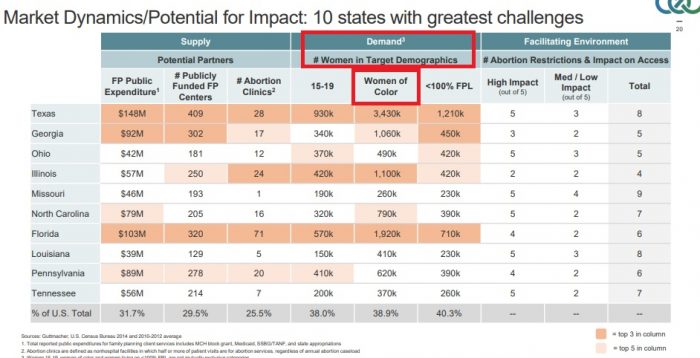
TARA Reproductive Health Investors Alliance targeting women of color
The report identifies “40 example investment opportunities,” matched to “five challenge-specific investment strategies”:
a) research and development,
b) legislation & litigation,
c) pricing & reimbursement,
d) service provision, and
e) care-seeking by underserved populations
As Live Action News has documented, the report states that, “~50% of abortions are repeat abortions (460K abortions/year)” and it defines “woman” as those “in need of high quality contraceptive and abortion services” though the report “acknowledge[s] that this is a vast simplification.” The report also adds, “The term ‘woman’ does not describe the identity of all persons who can get pregnant; conversely, not all those who identify as a woman can get pregnant.”
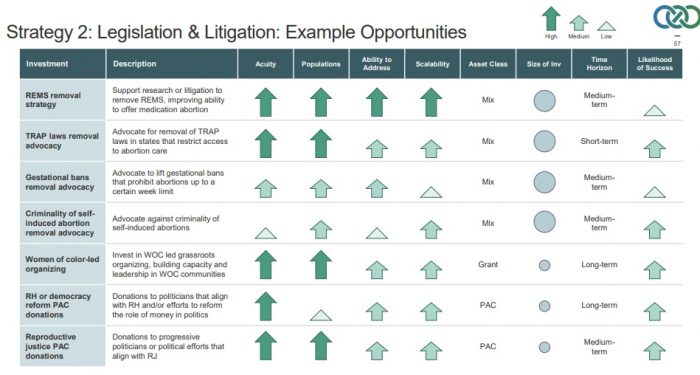
TARA Reproductive Health Investors Alliance legislative strategies
Pro-abortion legislative and litigation strategies suggested in the report include:
- REMS removal strategy (This is the risk management system that governs the abortion pill RU486)
- TRAP laws removal advocacy
- Gestational bans removal advocacy
- Criminality of self-induced abortion removal advocacy
- Organizing led by women of color
- Reproductive health or democracy reform PAC donations
- Reproductive justice PAC donations
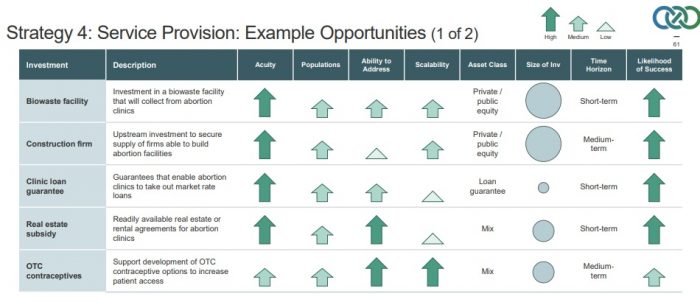
Reproductive Health Investors Alliance strategy 1 of 2
Strategies that benefit abortion facilities include:
- Investment in a biowaste facility that will collect from the facilities
- Upstream investment to secure supply of firms able to build the facilities
- Guarantees that enable the facilities to take out market rate loans
- Readily available real estate or rental agreements for the facilities
- Facilitate and train NPs, CNMs, PAs to commit abortions
- Provide funding or loans for independent providers to join a telemedicine network
- Innovations in telemedicine, mobile services, or at-home services that improve access
- Provide free pregnancy diagnosis in abortion facilities to combat pregnancy resource centers
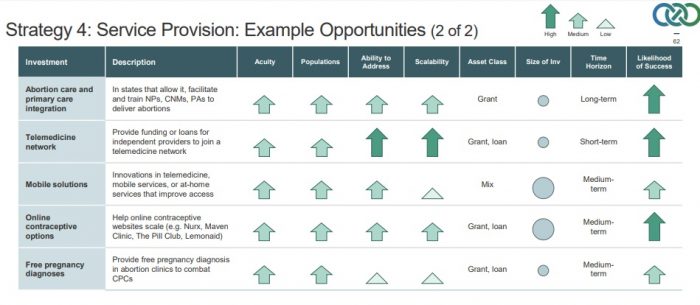
Reproductive Health Investors Alliance strategy 2 of 2
Statistics from report unintentionally point to pro-life advances:
- Since 2010, 338 state abortion restrictions have been adopted.
- 90% of all U.S. counties lack an abortion provider.
- 162 abortion providers closed down between 2011-2016. Only 21 abortion facilities opened during the same period.
- An estimated 16 abortion facilities close each year due to financial challenges.
- As of 2008, 97% of nonmetropolitan counties lacked an abortion provider.
- There are an estimated 2,300 to 3,500 CPCs in the U.S. while there are only 1,800 abortion facilities.
- Pregnancy resource centers outnumber these facilities 2:1.
- Cost and difficulty getting malpractice insurance for independent providers is one of the biggest financial challenges for already resource strapped abortion facilities.
- Viewing an ultrasound may contribute to a small proportion of women with medium or low decision certainty deciding to continue the pregnancy.
- More than a third of Planned Parenthood’s budget comes from Medicaid, putting Planned Parenthood at risk if Medicaid funding is blocked.
The report proves the length abortion supporters intend to go to in order to guarantee the “right” to end the lives of tiny humans persons in the womb. And it clearly shows the impact that pro-life legislation, pro-life activism, and pro-life pregnancy centers are having on the abortion industry.







